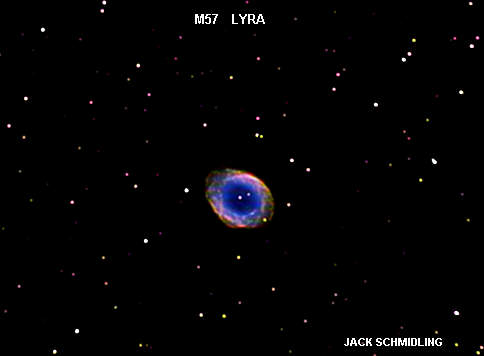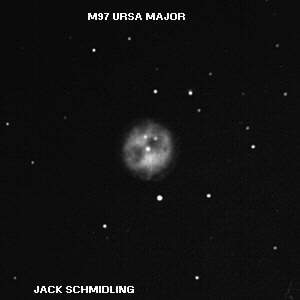
M97, THE OWL NEBULA
IN URSA MAJOR
M97 became known as the Owl nebula from its appearance on a drawing made with Lord Rosse's 72" telescope in 1848. Although difficult to recognize in a typical backyard telescope, the owl face is easily recorded on today's film with just about any size
insturment. M97 is about 1.5 light years in diameter and lies at a distance of about 2600 light years.
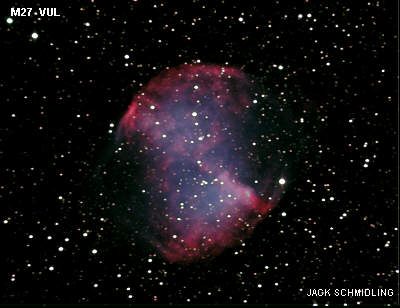
M27, The Dumbell Nebula in Vulpecula
M27 lies about 1250 light years away is nearly 3 light years in length. If the Sun
were the central star, the glowing gas would extend almost to our nearest stellar
neighbor, Alpha Centauri.

NGC 7293, The Helix Nebula in Aquarius
Although bright enough to be visible in binoculars, it is not an easy target for a
telescope as it's light is spread over an area half the size of the full Moon. It is
a bit like not seeing the trees because the forest gets in the way.
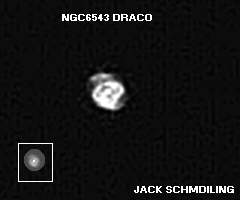
NGC 6543
The Cat's Eye Nebula in Draco
The central image is greatly enlarged and highly processed to bring out some of the detail in this, actually, very complex object.
The smaller image in the box is only contrast and brightness adjusted and is very
much like what this planetary looks like visually in the 16" telescope.
NGC 6543 is one of the prettiest objects in the sky. Although it is nothing more than a blue-green glow surrounding a tiny star, it holds my interest far longer than other more highly structured objects.
One could easily describe it as a glittering diamond in a blue velvet case. The star is not always easy to see as it seems to come and go as atmospheric conditions change and this is what adds to its beauty.
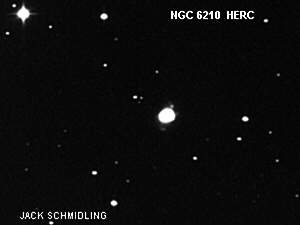
NGC 6210, The Steam Engine Nebula in Hercules
Planetary Nebula, NGC 6905 in Delphinus

NGC 6905, a Montage
What I am lacking in information on this planetary, I am making up in images.
This montage is composed of 3 film photos and one CCD image. It is impossible
to capture all the structure of this object in a single image. The CCD resolves the
central star best and one of the photos brings out the "wings", while the other two
show detail in the disk not visible in either of the others.
The photos were 30 and a 60 min exposures on hypered Techpan and the CCD image was 60 seconds on the ST4; all taken through the 16" Newt.
NGC 7009
The Saturn Nebula in Aquarius
-
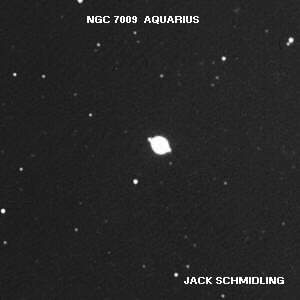
The Saturn Nebula is named for its striking resemblance to the planet Saturn.
NGC 7009 is about .5 light years in diameter and about 3900 light years from the Sun.
This photo was a 40 minute exposure on Hypered TechPan through the 16" Newt.
NGC 2392, The Eskimo in Gemini
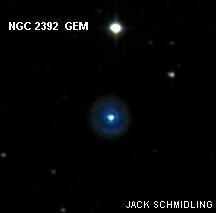
The Eskimo nebula is so named for its not-so-striking resemblance to an Eskimo in a parka. This can be seen in some film photos but is not obvious in CCD imges.
This was a 60 second exposure with the MX5C and the 16" telescope.
NGC2440
Planetary Nebula in Puppis
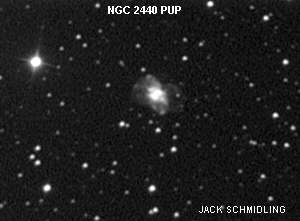
Although looking more like a remote spiral galaxy, NGC 2440 is actually an irregular planetary nebula in our own galaxy.
This image was a 1 min exposure with the MX5 through the 16" telescope.

M76
The Little Dumbell in Perseus
M76 lies at a distance of about 2000 light years and is about a light year in diameter.
This image was a 15 minute exposure taken with the MX5C CCD camera on the 16" telescope.
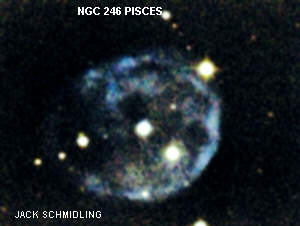
NGC246 is one of the largest Planetary Nebulae as seen from the Earth.
This image was a 30 minute exposure with the MX5C through the 16" telescope.
NGC 7635, THE BUBBLE NEBULA
NGC 7635 is one of the most dramatic objects in the sky. As with the Horsehead Nebula, the name Bubble says it all.
I was always under the impression that this object was a planetary nebula but the paragraph quoted below from NASA does not seem to indicate this explanation. Nevertheless, I will add it to the planetary nebula page.

This image was a 20 min exposure with the MX7C through the 16" telescope.
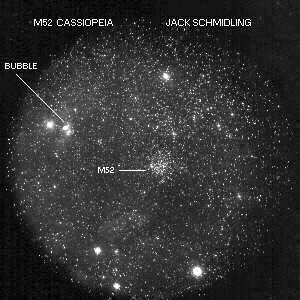
This film photo shows the location of the Bubble
with reference to the galactic star cluster, M52.
The following is the text from the NASA Photo of the Day which featured a new Hubble image:
Explanation: What created this huge space bubble? A massive star
The referenced image can be found at:
HST Bubble
All photos taken with the...JSP ASTROCAMERA
